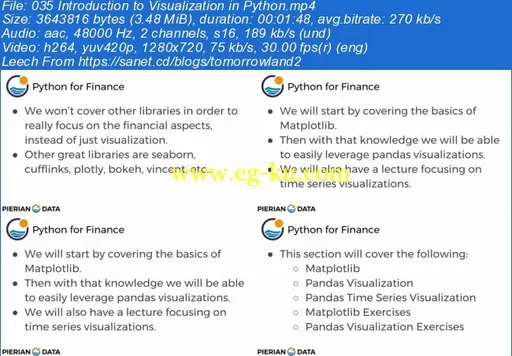
$195 | Duration: 17 hours | Video: h264, 1280x720 | Audio: AAC, 44100 Hz, 2 Ch | 2.4 GB
Genre: eLearning | Language: English | Project Files
BESTSELLING | Last updated 8/2017
What Will I Learn?
Use NumPy to quickly work with Numerical Data
Use Pandas for Analyze and Visualize Data
Use Matplotlib to create custom plots
Learn how to use statsmodels for Time Series Analysis
Calculate Financial Statistics, such as Daily Returns, Cumulative Returns, Volatility, etc..
Use Exponentially Weighted Moving Averages
Use ARIMA models on Time Series Data
Calculate the Sharpe Ratio
Optimize Portfolio Allocations
Understand the Capital Asset Pricing Model
Learn about the Efficient Market Hypothesis
Conduct algorithmic Trading on Quantopian
Requirements
Some knowledge of programming (preferably Python)
Ability to Download Anaconda (Python) to your computer
Basic Statistics and Linear Algebra will be helpful
Description
Welcome to Python for Financial Analysis and Algorithmic Trading! Are you interested in how people use Python to conduct rigorous financial analysis and pursue algorithmic trading, then this is the right course for you!
This course will guide you through everything you need to know to use Python for Finance and Algorithmic Trading! We’ll start off by learning the fundamentals of Python, and then proceed to learn about the various core libraries used in the Py-Finance Ecosystem, including jupyter, numpy, pandas, matplotlib, statsmodels, zipline, Quantopian, and much more!
We’ll cover the following topics used by financial professionals:
Python Fundamentals
NumPy for High Speed Numerical Processing
Pandas for Efficient Data Analysis
Matplotlib for Data Visualization
Using pandas-datareader and Quandl for data ingestion
Pandas Time Series Analysis Techniques
Stock Returns Analysis
Cumulative Daily Returns
Volatility and Securities Risk
EWMA (Exponentially Weighted Moving Average)
Statsmodels
ETS (Error-Trend-Seasonality)
ARIMA (Auto-regressive Integrated Moving Averages)
Auto Correlation Plots and Partial Auto Correlation Plots
Sharpe Ratio
Portfolio Allocation Optimization
Efficient Frontier and Markowitz Optimization
Types of Funds
Order Books
Short Selling
Capital Asset Pricing Model
Stock Splits and Dividends
Efficient Market Hypothesis
Algorithmic Trading with Quantopian
Futures Trading
Who is the target audience?
Someone familiar with Python who wants to learn about Financial Analysis!

发布日期: 2017-08-18